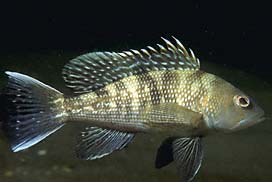
Centropristis striata
Sea Bass, Black Fish, Black Bass, Rockfish, Talywag
Black Sea Bass is easily identified by body shape, fin characteristics and color. Overall, the color is black for the larger individuals and arid, dusky-brown for the smaller ones. The exposed parts of scales are paler than the margins, giving the fish the appearance of being barred with a series of longitudinal, pale dots. The belly is only slightly lighter than the sides, and is never white. The fins are dark, and the dorsal is marked with a series of white spots and bands. The upper portion of the caudal fin generally ends as a filament. During the spawning season, large males have a conspicuous blue nuchal hump.
Black Sea Bass are opportunistic feeders, eating whatever is available. They are particularly fond of crabs, shrimps, worms, clams, and small fishes. Bass caught in deep water and then quickly retrieved to the surface, often regurgitate their food, thus
Their range is from Maine south to the Florida Keys and in the eastern part of the Gulf of Mexico.
The Black Sea Bass inhabits irregular hard-bottom areas such as wrecks, reefs and rock outcroppings from Cape Cod to Cape Canaveral. There are believed to be two populations: one north of Cape Hatteras and the other south of Cape Hatteras. The two populat
Black Sea Bass average 1-2 pounds and 13 inches in length, although they can reach up to 6 pounds and 24 inches.
10 pounds, 4 ounces (IGFA)